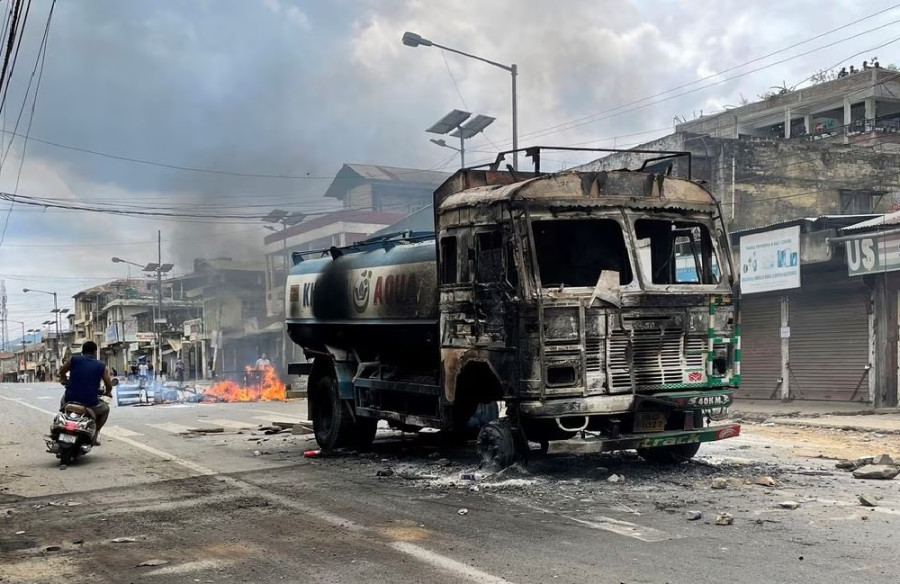Columns
Manipur, FMR and violence
It is easy to blame the refugees for the violence in Manipur instead of considering the poor governance.
Smruti S Pattanaik
On September 23, Manipur Chief Minister Biren Singh asked the Home Ministry to suspend the Free Movement Regime (FMR) that existed between Manipur and Myanmar blaming it for the recurring violence in the state. In fact, the FMR had already been suspended in September 2022 after the military takeover in Myanmar resulted in an influx of refugees to India. Yet, it is being blamed for the violence in Manipur.
Prior to the introduction of the FMR, the government of India had notified the Restricted Areas Act which stipulates, “No such registration would be required if the Myanmar nationals are only passing through the State by road with no intention of staying in that particular State." The FMR enables Myanmar nationals to spend 72 hours within 16 km after entering Manipur and is valid for a year. The same is true for Manipuris going to Myanmar.
The military takeover in Myanmar and the violence that ensued directly impacted the border states of Manipur and Mizoram. Given the ethno-cultural and tribal linkages, both Indian states opened the door to the Chin-Kuki-Zo people of Myanmar against the Home Ministry's direction.
Violence in Manipur
The violence started on March 3 when a tribal solidarity march against reservation for Meiteis led to clashes. A video circulated on social media showing two Kuki women being sexually assaulted by Meitei armed groups. As the violence continued unabated, the Meitei community and the chief minister, who belongs to this community, blamed the violence on Myanmarese nationals, regarded as “illegal immigrants” and not “refugees” who belong to the Kuki-Zo tribe. The Kuki community has denied the role of outsiders in perpetrating the violence.
Manipur has seen frequent occurrences of violence. The annual report of the Indian Ministry of Home Affairs for 2022-23 revealed that 137 out of the 201 incidents of insurgency related violence took place in Manipur only.
While the FMR has come under scrutiny, it is important to see why it was introduced in the larger context of border management. The FMR was introduced in 2018 as part of the Indian government’s Act East policy that is keenly pursued to link up with Southeast Asia. The ethno-cultural linkages that exist between the Chin-Kuki-Mizo people living in Manipur and Mizoram in India and Myanmar sharing a common ancestry are well known.
Some analysts point out that the existing ethnic cleavages in Manipur can be attributed to the governance factor in that state. The Kukis generally perceive that the administration is biased against them, and the largely Meitei-dominated police force just watched when violence was perpetrated against them. There are land ownership issues and the Meiteis resent the Kuki domination of forest land. The fight against drugs is seen as being directed against the Kuki community.
The problem in Manipur started when the High Court recommended reservation for Meiteis, the dominant community in Manipur. The Meiteis who are Hindus are mostly concentrated in Imphal Valley while the Kukis, mainly Christian, dominate the hills. Kukis are concentrated near the Myanmar border like the Nagas. Like the Meiteis, the Nagas also consider Kukis as outsiders. The Kukis drew support from their ethnic community in Mizoram. The Mizo National Front went to the extent of demanding a separate administration for the Kuki community in Manipur, and one also heard echoes of greater Mizoram.
While the chief minister blamed the FMR, it needs to be underlined that India’s border with Myanmar remains porous. An unnamed official said, “If removing the FMR resolves the problem of Manipur and illegal immigration, then it will be a good initiative. Unfortunately, that will not stop the movement of people across the border. The government at least has some data of people crossing he border, but once the FMR is removed, there will be no records.” The FMR in Manipur may be suspended or stopped, but the porous border would be used by ethnic communities. In any case, Mizoram hosts a majority of the refugees from Myanmar belonging to the Zo-Kuki-Chin community.
It is easy to blame the refugee community for the violence in Manipur instead of taking the governance factor into account. All the states in the north-eastern part of India have an ethnic mix that sometimes leads to violence. Cross-border ethno-cultural linkages cannot be wished away. Amending the FMR will not help the situation. Already, the National Unity Government, the Myanmar government in exile, has issued a statement asking the Kuki-Chin people from Myanmar who have taken refuge in Mizoram and Manipur to stay away from the conflict.
Role of Mizoram
Support for the Kukis has come not just from Myanmar nationals but also from Mizoram. Already, the Zo people from the Chittagong Hill Tracts are migrating to Mizoram. Given the dynamics, Delhi requested the Mizoram chief minister to talk to the Indigenous Tribal Leaders’ Forum, consisting of several Kuki Zo organisations, to help in bringing peace. However, the chief minister has extended support to the Kukis saying that Mizoram cannot keep quiet regarding the violence being perpetrated against them that has led to their being internally displaced.
The threat by underground Mizo militant groups has spread panic among the Meiteis living in Mizoram. It is important to stop this conflict from spreading given the ethnic mosaic that India’s northeast represents.
Tribal fault lines became visible after the conflict in Manipur, and this will have long repercussion for the state. The Act East policy remains an important pillar of India’s foreign policy. With the deepening of ethnic fault lines, an eruption of violence is possible which will make it difficult for the government to move ahead with several connectivity projects that it has undertaken in Myanmar besides the trilateral highway that India is so keen to develop. The FMR only regulates cross-border movement and keeps a record of such movements. The conflict in Manipur requires a deeper diagnosis. Blaming it on cross-border support will not resolve the antagonism that exists between the tribes.




 9.12°C Kathmandu
9.12°C Kathmandu















